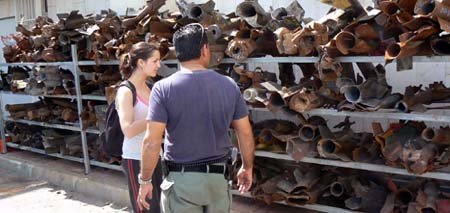This website was created in 2008 and taken offline in 2018.
|
||||||
March 5, 2008
|
||||||
 A loaded truck approaches the Karni crossing into Gaza: on March 5 2008 there was heavy truck traffic into and out of Gaza, but the American and European newspapers were talking about an Israeli "blockade" of Gaza. |
||||||
Driving to the Egyptian border from Sderot is not difficult. Highway 232 is a wide and heavily-traveled road, and the trip can be made easily in less than an hour. The Gaza strip is 25 miles long, seven and one-half miles wide at its widest point, and covers 139 square miles. For comparison, Manhattan Island is 23 square miles. Israel and Gaza share a 35-mile-long common border. There are numerous crossings from Israel into Gaza. I had read that only the Karni and Erez (near Ashkelon) crossings were open, but this did not seem to be true. There was heavy truck traffic at all crossings except Kerem Shalom, the Egyptian and Rafiah entry points. |
 Into Egypt or Gaza: the Kerem Shalom Terminal is located where Israel, Egypt, and Gaza join. |
|||||
 All along the highway going from Sderot down toward Egypt, paralleling the Gaza border, there is highly-developed farming, including acres and acres of greenhouses. Israel exports its agricultural products to the world. When Israeli settlements in Gaza were dismantled in 2005, many greenhouses were left intact in an attempt to provide an economic opportunity for Gazans. The greenhouses left behind were looted and destroyed. |
||||||
 Truckers wait to go into Gaza at the Sufa crossing. |
The prohibition against providing "aid and comfort to the enemy" somehow does not apply along the Israel/Gaza border. Even in what is supposed to be a blockade, there is major truck traffic into and out of Gaza, delivering humanitarian and other goods. "Why are we supplying them so they can shoot rockets at us?" is a question I frequently have heard in the Sderot area. Before the Hamas takeover of Gaza, about 120,000 Gazans crossed the border daily to work in Egypt. Most of these jobs have been lost, and the amount of commerce between the two areas is greatly reduced. |
|||||
 At the Kerem Shalom terminal, a sign points to the Rafiah crossing between Egypt and Gaza, and the Nizzana crossing, between Egypt and Israel. |
 A truck leaves Gaza at the Qatif crossing. |
|||||
 Irrigation of farmlands in Israel. |
Losses for everyone: The disastrous Hamas takeover of Gaza has lead to losses for both sides of the border: jobs lost by Gazans; Israeli expertise in helping develop Gazan farmlands lost; the loss of Israel as a major trading partner for the farmers and manufacturers in Gaza; Gazan assistance in helping Israel further develop its agricultural and manufacturing industries. And more tragically, the loss of life on both sides in a low-level but ongoing war. In driving the border it's not hard to imagine a vigorous trade between the two areas, with open crossings for workers and materials. This existed before Hamas, and was growing stronger. |
|||||
 Bad neighbors: In this photo the Gaza city of Beit Hanun can be seen on the left, and the Israeli city of Sderot can be seen on the right. What is not seen is the tracks of kassam rockets as they are fired from Beit Hanun toward Sderot, or the infrequent Israeli incursions in Gaza to try to stop the fire. |
||||||

